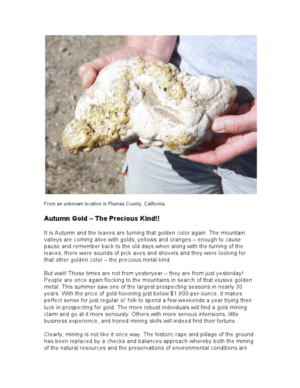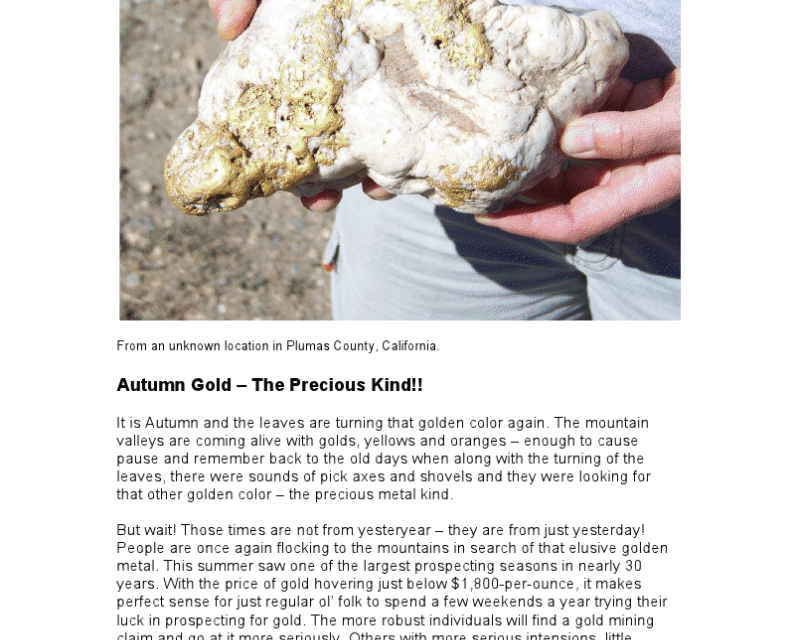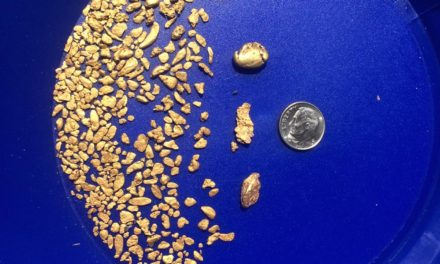By Charles Watson
[media-credit name=”Charles Watson” align=”alignleft” width=”300″] [/media-credit]It is Autumn and the leaves are turning that golden color again. The mountain valleys are coming alive with golds, yellows and oranges – enough to cause pause and remember back to the old days, when along with the turning of the leaves, there were sounds of pick axes and shovels and they were looking for that other golden color, the precious metal kind.
[/media-credit]It is Autumn and the leaves are turning that golden color again. The mountain valleys are coming alive with golds, yellows and oranges – enough to cause pause and remember back to the old days, when along with the turning of the leaves, there were sounds of pick axes and shovels and they were looking for that other golden color, the precious metal kind.
But wait! Those times are not from yesteryear – they are from just yesterday. People are once again flocking to the mountains in search of that elusive golden metal. This summer saw one of the largest prospecting seasons in nearly thirty years. With the price of gold hovering just below $1800 per ounce, it makes perfect sense for just regular ol’ folk to spend a few weekends a year trying their luck in prospecting for gold. The more robust individuals will find a gold mining claim and go at it more seriously. Others with more serious intentions, a little business experience, and honed mining skills will indeed find their fortune.
Clearly mining is not what it once was. The historic rape and pillage of the ground has been replaced by a checks and balances approach whereby both the mining of the natural resources and the preservation of environmental conditions are honored. Miners and environmentalists take vastly different views on this balance, however, if each acknowledges the others views, a balance can be attained with a win-win outcome.
Indeed, there have been some new mining regulations and rule changes. Many have been for good reasons while others were purely political grandstanding with ulterior motives. But like prohibition was for alcohol in the 1920s, a common sense balance will prevail such that abuse is no longer tolerated and honest citizens can pursue a responsible and accountable course when choosing to mine.
Today, mining permits are required for nearly all levels above recreational panning and sluice boxes. Permits require the prospectors think about what they are doing, how they will go about it, and how they will restore the site when they are finished. Regulations require the miners to look around their claim, not only for what contains minerals and what they want to mine , but what has other important values such as biology, archaeology and aesthetics.
Mining permits come in all shapes and sizes, which largely depends on the miner and the area they want to mine. The larger the mining project, the larger the permit. Permits are like guide books for all those concerned including miners, regulators and environmentalists. Once crafted, it is a well planned and organized “bible” for how mining and prospecting activities are to unfold.
Costs for mining permits vary as well. Consult an experienced geologist or engineer when considering a mining permit. Their knowledge can save you time and money, as well as help you find the gold!
Autumn is the end of the mining season in the mountains. The rains will be here soon and the snow will fly shortly after that, burying everything in a deep white blanket until Spring. It is time that responsible miners pack up their equipment, reclaim their digs and prepare for the next season. They take one last look around and try to imagine where that big pocket of gold could be, then mosey down the trail and back to their other lives.
It is a thrill to find your first gold speck, flake or nugget. Once you do, you will be hooked forever. It is fun for the whole family, and who knows, maybe just maybe, if you are a wee bit lucky…you too will jump for joy, click your heels and yell “Eureka! I found it!”
Charles P. Watson is the Chief Geologist at Advanced Geologic Exploration located in Chester, Ca. He can be reached at cwatson@advancedgeologic.com or at advancedgeologic.com.












